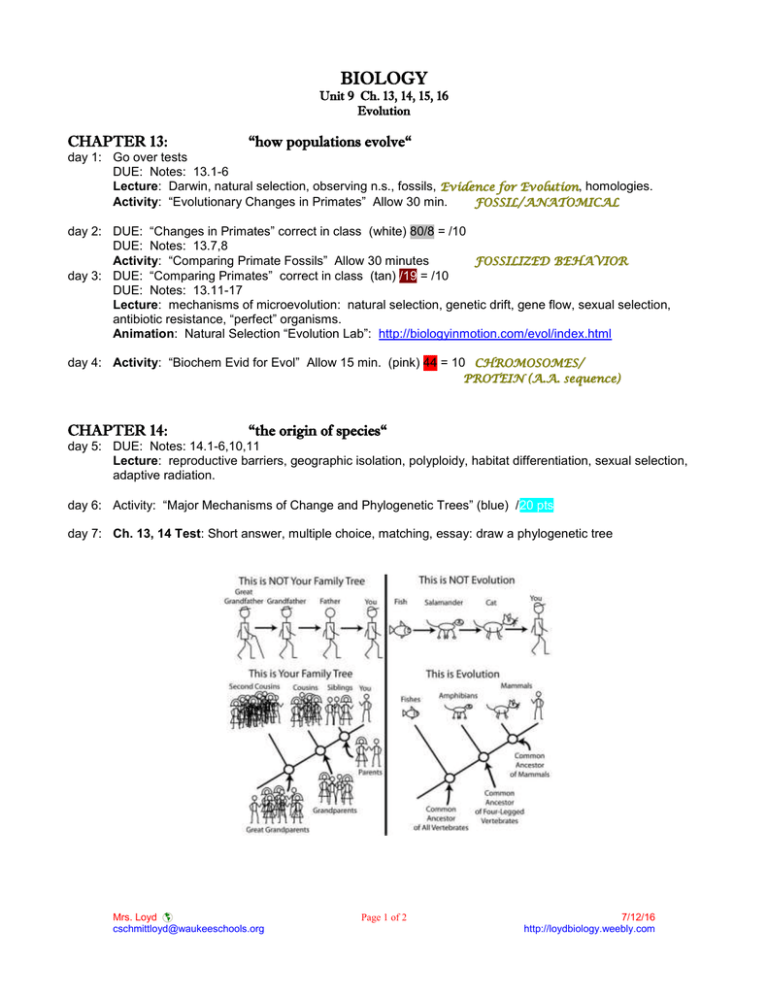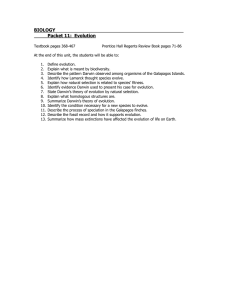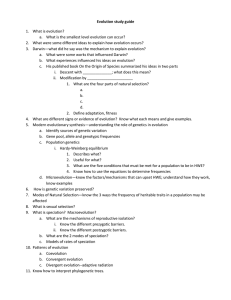BIOLOGY CHAPTER 13: “how populations evolve“
advertisement

BIOLOGY Unit 9 Ch. 13, 14, 15, 16 Evolution CHAPTER 13: “how populations evolve“ day 1: Go over tests DUE: Notes: 13.1-6 Lecture: Darwin, natural selection, observing n.s., fossils, Evidence for Evolution, homologies. Activity: “Evolutionary Changes in Primates” Allow 30 min. FOSSIL/ANATOMICAL day 2: DUE: “Changes in Primates” correct in class (white) 80/8 = /10 DUE: Notes: 13.7,8 Activity: “Comparing Primate Fossils” Allow 30 minutes FOSSILIZED BEHAVIOR day 3: DUE: “Comparing Primates” correct in class (tan) /19 = /10 DUE: Notes: 13.11-17 Lecture: mechanisms of microevolution: natural selection, genetic drift, gene flow, sexual selection, antibiotic resistance, “perfect” organisms. Animation: Natural Selection “Evolution Lab”: http://biologyinmotion.com/evol/index.html day 4: Activity: “Biochem Evid for Evol” Allow 15 min. (pink) 44 = 10 CHROMOSOMES/ PROTEIN (A.A. sequence) CHAPTER 14: “the origin of species“ day 5: DUE: Notes: 14.1-6,10,11 Lecture: reproductive barriers, geographic isolation, polyploidy, habitat differentiation, sexual selection, adaptive radiation. day 6: Activity: “Major Mechanisms of Change and Phylogenetic Trees” (blue) /20 pts day 7: Ch. 13, 14 Test: Short answer, multiple choice, matching, essay: draw a phylogenetic tree Mrs. Loyd cschmittloyd@waukeeschools.org Page 1 of 2 7/12/16 http://loydbiology.weebly.com Honors Biology Ch. 13 “How Populations Evolve” Objectives Darwin’s Theory of Evolution 13.1 Briefly summarize the history of evolutionary thought. 13.1 Explain how Darwin’s voyage on the Beagle influenced his thinking. 13.1 Describe the ideas and events that led to Darwin’s 1859 publication of The Origin of Species. 13.2 Explain how the work of Thomas Malthus and the process of artificial selection influenced Darwin’s development of the idea of natural selection. 13.2 Explain why individuals cannot evolve and why evolution does not lead to perfectly adapted organisms. 13.3 Describe two examples of natural selection known to occur in nature. Note three key points about how natural selection works. 13.4 Explain how fossils form, noting examples of each process. 13.4 Explain how the fossil record provides some of the strongest evidence of evolution. 13.5 Explain how biogeography, comparative anatomy, comparative embryology, and molecular biology support evolution. 13.6 Explain how evolutionary trees are constructed and used to represent ancestral relationships. The Evolution of Populations 13.7 Define the gene pool, a population, and microevolution. 13.8 Explain how mutation and sexual recombination produce genetic variation. 13.8 Explain why prokaryotes can evolve more quickly than eukaryotes. Mechanisms of Microevolution 13.11 Define genetic drift and gene flow. Explain how the bottleneck effect and the founder effect influence microevolution. 13.11 Explain how genetic bottlenecks threaten the survival of certain species. 13.12 Explain why natural selection is the only mechanism that leads to adaptive evolution. 13.13 Distinguish between stabilizing selection, directional selection, and disruptive selection. Describe an example of each. 13.14 Define and compare intrasexual selection and intersexual selection. 13.15 Explain how antibiotic resistance has evolved. 13.16 Explain how genetic variation is maintained in populations. 13.16 Explain what is meant by neutral variation. 13.17 Give four reasons why natural selection cannot produce perfection. Ch. 14 objectives “The Origin of Species” Concepts of Species 14.1 Define and distinguish between microevolution and macroevolution. 14.3 Describe five types of prezygotic barriers and three types of postzygotic barriers that prevent populations belonging to closely related species from interbreeding. Mechanisms of Speciation 14.4 Explain how geologic processes can fragment populations and lead to speciation. 14.5 Explain how sympatric speciation can occur, noting examples in plants and animals. (This goes along with 14.7) 14.7 Explain how reproductive barriers might evolve in isolated populations of organisms. Refer to studies of laboratoryraised fruit flies, Japanese land snails, and monkey flowers. 14.10 Describe the circumstances that led to the adaptive radiation of the Galápagos finches. 14.11 Compare the gradualism model and the punctuated equilibrium model of evolution. Explain how each model applies to the fossil record. Mrs. Loyd cschmittloyd@waukeeschools.org Page 2 of 2 7/12/16 http://loydbiology.weebly.com







